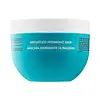What's inside
What's inside
 Key Ingredients
Key Ingredients

No key ingredients
 Benefits
Benefits

 Concerns
Concerns

 Ingredients Side-by-side
Ingredients Side-by-side

Water
Skin ConditioningCetearyl Alcohol
EmollientDimethicone
EmollientCanola Oil
EmollientParfum
MaskingBehentrimonium Methosulfate
Cetyl Alcohol
EmollientArgania Spinosa Kernel Oil
EmollientButyrospermum Parkii Butter
Skin ConditioningHydrolyzed Vegetable Protein Pg-Propyl Silanetriol
Skin ConditioningPEG-60 Almond Glycerides
EmulsifyingAcetamide Mea
HumectantButylene Glycol
HumectantCeteareth-20
CleansingBehentrimonium Chloride
PreservativeIsopropyl Alcohol
SolventSteareth-2
EmulsifyingPhenoxyethanol
PreservativeCaprylyl Glycol
EmollientChlorphenesin
AntimicrobialCitric Acid
BufferingEugenol
PerfumingButylphenyl Methylpropional
PerfumingHydroxyisohexyl 3-Cyclohexene Carboxaldehyde
MaskingLinalool
PerfumingAlpha-Isomethyl Ionone
PerfumingWater, Cetearyl Alcohol, Dimethicone, Canola Oil, Parfum, Behentrimonium Methosulfate, Cetyl Alcohol, Argania Spinosa Kernel Oil, Butyrospermum Parkii Butter, Hydrolyzed Vegetable Protein Pg-Propyl Silanetriol, PEG-60 Almond Glycerides, Acetamide Mea, Butylene Glycol, Ceteareth-20, Behentrimonium Chloride, Isopropyl Alcohol, Steareth-2, Phenoxyethanol, Caprylyl Glycol, Chlorphenesin, Citric Acid, Eugenol, Butylphenyl Methylpropional, Hydroxyisohexyl 3-Cyclohexene Carboxaldehyde, Linalool, Alpha-Isomethyl Ionone
Water
Skin ConditioningCetearyl Alcohol
EmollientAstrocaryum Murumuru Seed Butter
EmollientBehentrimonium Chloride
PreservativeOctafluoropentyl Methacrylate
PPG-3 Benzyl Ether Ethylhexanoate
EmollientPPG-3 Benzyl Ether Myristate
EmollientCetyl Alcohol
EmollientLauryl/Myristyl Polyricinoleate
EmollientPCA
HumectantMyrica Cerifera Fruit Wax
EmollientSodium PCA
HumectantSodium Lactate
BufferingJojoba Esters
EmollientArginine
MaskingPolyglycerin-3
HumectantGlycine
BufferingLinoleamidopropyl Dimethylamine Dimer Dilinoleate
Skin ConditioningAlanine
MaskingSerine
MaskingHelianthus Annuus Seed Wax
Skin ConditioningValine
MaskingGuar Hydroxypropyltrimonium Chloride
Skin ConditioningProline
Skin ConditioningThreonine
Quaternium-87
CleansingIsoleucine
Skin ConditioningHistidine
HumectantPhenylalanine
MaskingPropylene Glycol
HumectantCetyl Hydroxyethylcellulose
Emulsion StabilisingHydroxyethylcellulose
Emulsion StabilisingCeteth-20
CleansingSteareth-20
CleansingPEG-75 Stearate
Glyceryl Stearate
EmollientParfum
MaskingGlycolic Acid
BufferingAspartic Acid
MaskingCetylpyridinium Chloride
AntimicrobialHydroxyacetophenone
AntioxidantLimonene
PerfumingHexyl Cinnamal
PerfumingLinalool
PerfumingCitronellol
PerfumingWater, Cetearyl Alcohol, Astrocaryum Murumuru Seed Butter, Behentrimonium Chloride, Octafluoropentyl Methacrylate, PPG-3 Benzyl Ether Ethylhexanoate, PPG-3 Benzyl Ether Myristate, Cetyl Alcohol, Lauryl/Myristyl Polyricinoleate, PCA, Myrica Cerifera Fruit Wax, Sodium PCA, Sodium Lactate, Jojoba Esters, Arginine, Polyglycerin-3, Glycine, Linoleamidopropyl Dimethylamine Dimer Dilinoleate, Alanine, Serine, Helianthus Annuus Seed Wax, Valine, Guar Hydroxypropyltrimonium Chloride, Proline, Threonine, Quaternium-87, Isoleucine, Histidine, Phenylalanine, Propylene Glycol, Cetyl Hydroxyethylcellulose, Hydroxyethylcellulose, Ceteth-20, Steareth-20, PEG-75 Stearate, Glyceryl Stearate, Parfum, Glycolic Acid, Aspartic Acid, Cetylpyridinium Chloride, Hydroxyacetophenone, Limonene, Hexyl Cinnamal, Linalool, Citronellol
Ingredients Explained
These ingredients are found in both products.
Ingredients higher up in an ingredient list are typically present in a larger amount.
This ingredient is a preservative and often used for it's anti-static properties. You'll most likely see this ingredient in hair conditioners.
It does not cause irritation or sensitization in leave-on products at 1-5%.
Cetearyl alcohol is a mixture of two fatty alcohols: cetyl alcohol and stearyl alcohol. It is mainly used as an emulsifier. Emulsifiers help prevent the separation of oils and products. Due to its composition, it can also be used to thicken a product or help create foam.
Cetearyl alcohol is an emollient. Emollients help soothe and hydrate the skin by trapping moisture.
Studies show Cetearyl alcohol is non-toxic and non-irritating. The FDA allows products labeled "alcohol-free" to have fatty alcohols.
This ingredient is usually derived from plant oils such as palm, vegetable, or coconut oils. There is debate on whether this ingredient will cause acne.
Due to the fatty acid base, this ingredient may not be Malassezia folliculitis safe.
Learn more about Cetearyl AlcoholCetyl Alcohol is a fatty alcohol. Fatty Alcohols are most often used as an emollient or to thicken a product.
Its main roles are:
Though it has "alcohol" in the name, it is not related to denatured alcohol or ethyl alcohol.
The FDA allows products labeled "alcohol-free" to have fatty alcohols.
Learn more about Cetyl AlcoholLinalool is a fragrance and helps add scent to products. It's derived from common plants such as cinnamon, mint, citrus, and lavender.
Like Limonene, this ingredient oxidizes when exposed to air. Oxidized linalool can cause allergies and skin sensitivity.
This ingredient has a scent that is floral, spicy tropical, and citrus-like.
Learn more about LinaloolParfum is a catch-all term for an ingredient or more that is used to give a scent to products.
Also called "fragrance", this ingredient can be a blend of hundreds of chemicals or plant oils. This means every product with "fragrance" or "parfum" in the ingredients list is a different mixture.
For instance, Habanolide is a proprietary trade name for a specific aroma chemical. When used as a fragrance ingredient in cosmetics, most aroma chemicals fall under the broad labeling category of “FRAGRANCE” or “PARFUM” according to EU and US regulations.
The term 'parfum' or 'fragrance' is not regulated in many countries. In many cases, it is up to the brand to define this term.
For instance, many brands choose to label themselves as "fragrance-free" because they are not using synthetic fragrances. However, their products may still contain ingredients such as essential oils that are considered a fragrance by INCI standards.
One example is Calendula flower extract. Calendula is an essential oil that still imparts a scent or 'fragrance'.
Depending on the blend, the ingredients in the mixture can cause allergies and sensitivities on the skin. Some ingredients that are known EU allergens include linalool and citronellol.
Parfum can also be used to mask or cover an unpleasant scent.
The bottom line is: not all fragrances/parfum/ingredients are created equally. If you are worried about fragrances, we recommend taking a closer look at an ingredient. And of course, we always recommend speaking with a professional.
Learn more about ParfumWater. It's the most common cosmetic ingredient of all. You'll usually see it at the top of ingredient lists, meaning that it makes up the largest part of the product.
So why is it so popular? Water most often acts as a solvent - this means that it helps dissolve other ingredients into the formulation.
You'll also recognize water as that liquid we all need to stay alive. If you see this, drink a glass of water. Stay hydrated!
Learn more about Water